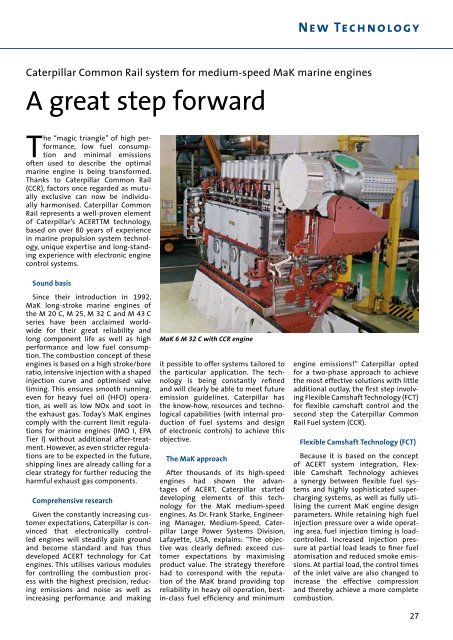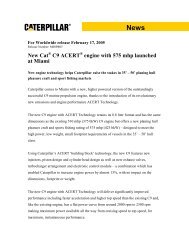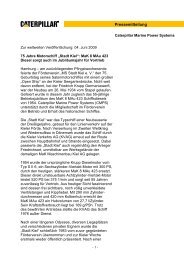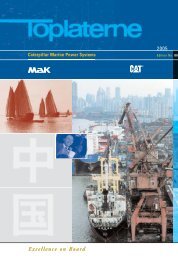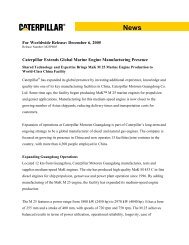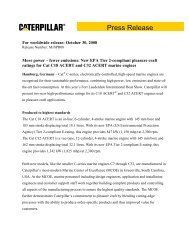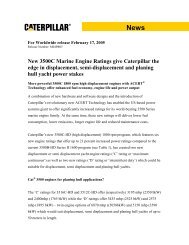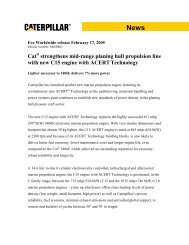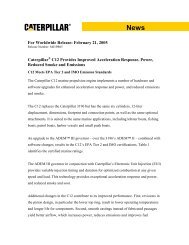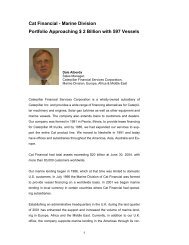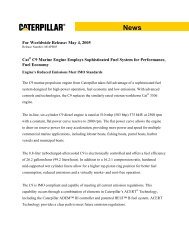Caterpillar Marine - Marine Engines Caterpillar
Caterpillar Marine - Marine Engines Caterpillar
Caterpillar Marine - Marine Engines Caterpillar
You also want an ePaper? Increase the reach of your titles
YUMPU automatically turns print PDFs into web optimized ePapers that Google loves.
<strong>Caterpillar</strong> Common Rail system for medium-speed MaK marine engines<br />
A great step forward<br />
The “magic triangle” of high performance,<br />
low fuel consumption<br />
and minimal emissions<br />
often used to describe the optimal<br />
marine engine is being transformed.<br />
Thanks to <strong>Caterpillar</strong> Common Rail<br />
(CCR), factors once regarded as mutually<br />
exclusive can now be individually<br />
harmonised. <strong>Caterpillar</strong> Common<br />
Rail represents a well-proven element<br />
of <strong>Caterpillar</strong>’s ACERTTM technology,<br />
based on over 80 years of experience<br />
in marine propulsion system technology,<br />
unique expertise and long-standing<br />
experience with electronic engine<br />
control systems.<br />
Sound basis<br />
Since their introduction in 1992,<br />
MaK long-stroke marine engines of<br />
the M 20 C, M 25, M 32 C and M 43 C<br />
series have been acclaimed worldwide<br />
for their great reliability and<br />
long component life as well as high<br />
performance and low fuel consumption.<br />
The combustion concept of these<br />
engines is based on a high stroke/bore<br />
ratio, intensive injection with a shaped<br />
injection curve and optimised valve<br />
timing. This ensures smooth running,<br />
even for heavy fuel oil (HFO) operation,<br />
as well as low NOx and soot in<br />
the exhaust gas. Today’s MaK engines<br />
comply with the current limit regulations<br />
for marine engines (IMO I, EPA<br />
Tier I) without additional after-treatment.<br />
However, as even stricter regulations<br />
are to be expected in the future,<br />
shipping lines are already calling for a<br />
clear strategy for further reducing the<br />
harmful exhaust gas components.<br />
Comprehensive research<br />
Given the constantly increasing customer<br />
expectations, <strong>Caterpillar</strong> is convinced<br />
that electronically controlled<br />
engines will steadily gain ground<br />
and become standard and has thus<br />
developed ACERT technology for Cat<br />
engines. This utilises various modules<br />
for controlling the combustion process<br />
with the highest precision, reducing<br />
emissions and noise as well as<br />
increasing performance and making<br />
MaK 6 M 32 C with CCR engine<br />
it possible to offer systems tailored to<br />
the particular application. The technology<br />
is being constantly refined<br />
and will clearly be able to meet future<br />
emission guidelines. <strong>Caterpillar</strong> has<br />
the know-how, resources and technological<br />
capabilities (with internal production<br />
of fuel systems and design<br />
of electronic controls) to achieve this<br />
objective.<br />
The MaK approach<br />
After thousands of its high-speed<br />
engines had shown the advantages<br />
of ACERT, <strong>Caterpillar</strong> started<br />
developing elements of this technology<br />
for the MaK medium-speed<br />
engines. As Dr. Frank Starke, Engineering<br />
Manager, Medium-Speed, <strong>Caterpillar</strong><br />
Large Power Systems Division,<br />
Lafayette, USA, explains: “The objective<br />
was clearly defined: exceed customer<br />
expectations by maximising<br />
product value. The strategy therefore<br />
had to correspond with the reputation<br />
of the MaK brand providing top<br />
reliability in heavy oil operation, bestin-class<br />
fuel efficiency and minimum<br />
New Technology<br />
engine emissions!” <strong>Caterpillar</strong> opted<br />
for a two-phase approach to achieve<br />
the most effective solutions with little<br />
additional outlay, the first step involving<br />
Flexible Camshaft Technology (FCT)<br />
for flexible camshaft control and the<br />
second step the <strong>Caterpillar</strong> Common<br />
Rail Fuel system (CCR).<br />
Flexible Camshaft Technology (FCT)<br />
Because it is based on the concept<br />
of ACERT system integration, Flexible<br />
Camshaft Technology achieves<br />
a synergy between flexible fuel systems<br />
and highly sophisticated supercharging<br />
systems, as well as fully utilising<br />
the current MaK engine design<br />
parameters. While retaining high fuel<br />
injection pressure over a wide operating<br />
area, fuel injection timing is loadcontrolled.<br />
Increased injection pressure<br />
at partial load leads to finer fuel<br />
atomisation and reduced smoke emissions.<br />
At partial load, the control times<br />
of the inlet valve are also changed to<br />
increase the effective compression<br />
and thereby achieve a more complete<br />
combustion.<br />
27


